CHRYSLER SEBRING CONVERTIBLE 2010 3.G Owner's Guide
Manufacturer: CHRYSLER, Model Year: 2010, Model line: SEBRING CONVERTIBLE, Model: CHRYSLER SEBRING CONVERTIBLE 2010 3.GPages: 457, PDF Size: 8.76 MB
Page 31 of 457
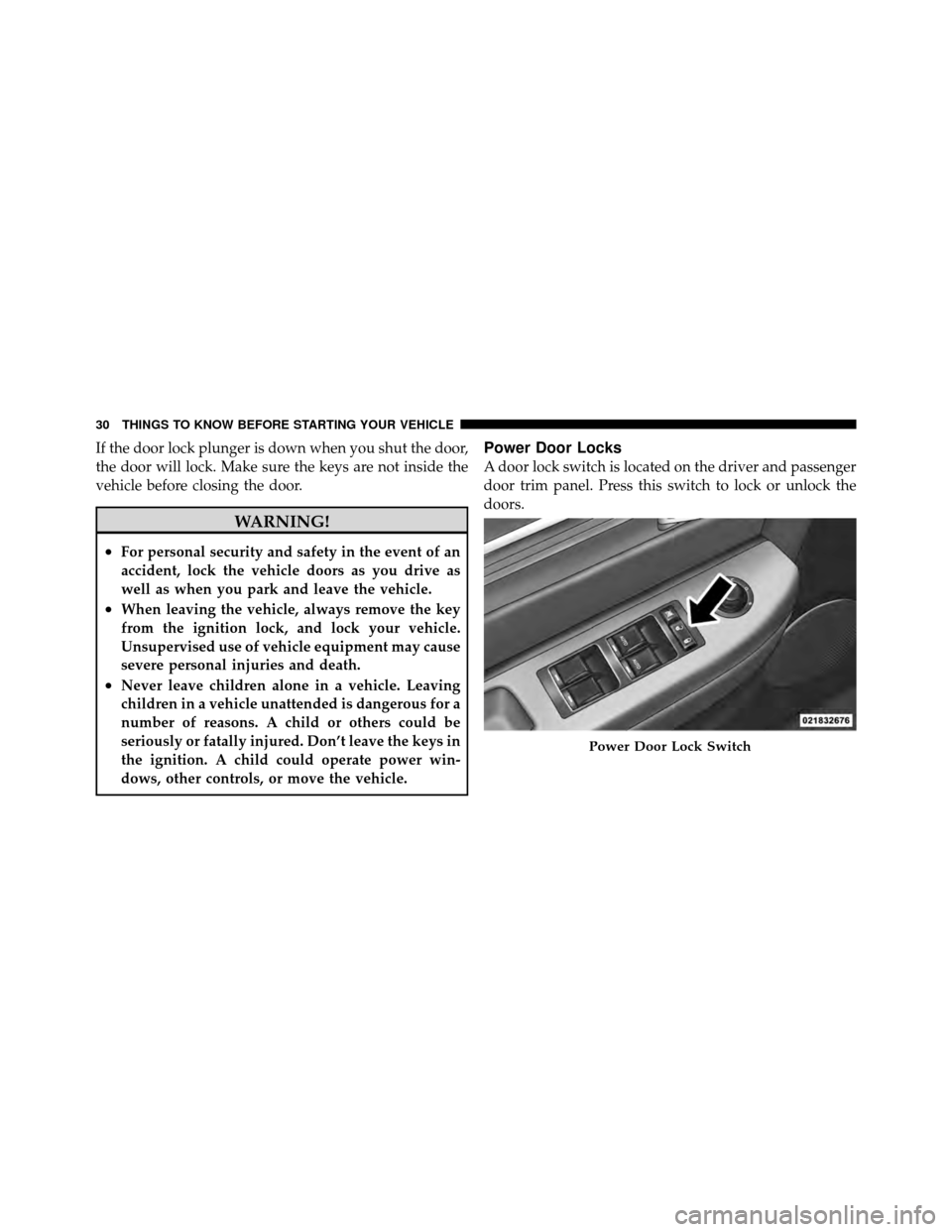
If the door lock plunger is down when you shut the door,
the door will lock. Make sure the keys are not inside the
vehicle before closing the door.
WARNING!
•For personal security and safety in the event of an
accident, lock the vehicle doors as you drive as
well as when you park and leave the vehicle.
•When leaving the vehicle, always remove the key
from the ignition lock, and lock your vehicle.
Unsupervised use of vehicle equipment may cause
severe personal injuries and death.
•Never leave children alone in a vehicle. Leaving
children in a vehicle unattended is dangerous for a
number of reasons. A child or others could be
seriously or fatally injured. Don’t leave the keys in
the ignition. A child could operate power win-
dows, other controls, or move the vehicle.
Power Door Locks
A door lock switch is located on the driver and passenger
door trim panel. Press this switch to lock or unlock the
doors.
Power Door Lock Switch
30 THINGS TO KNOW BEFORE STARTING YOUR VEHICLE
Page 32 of 457
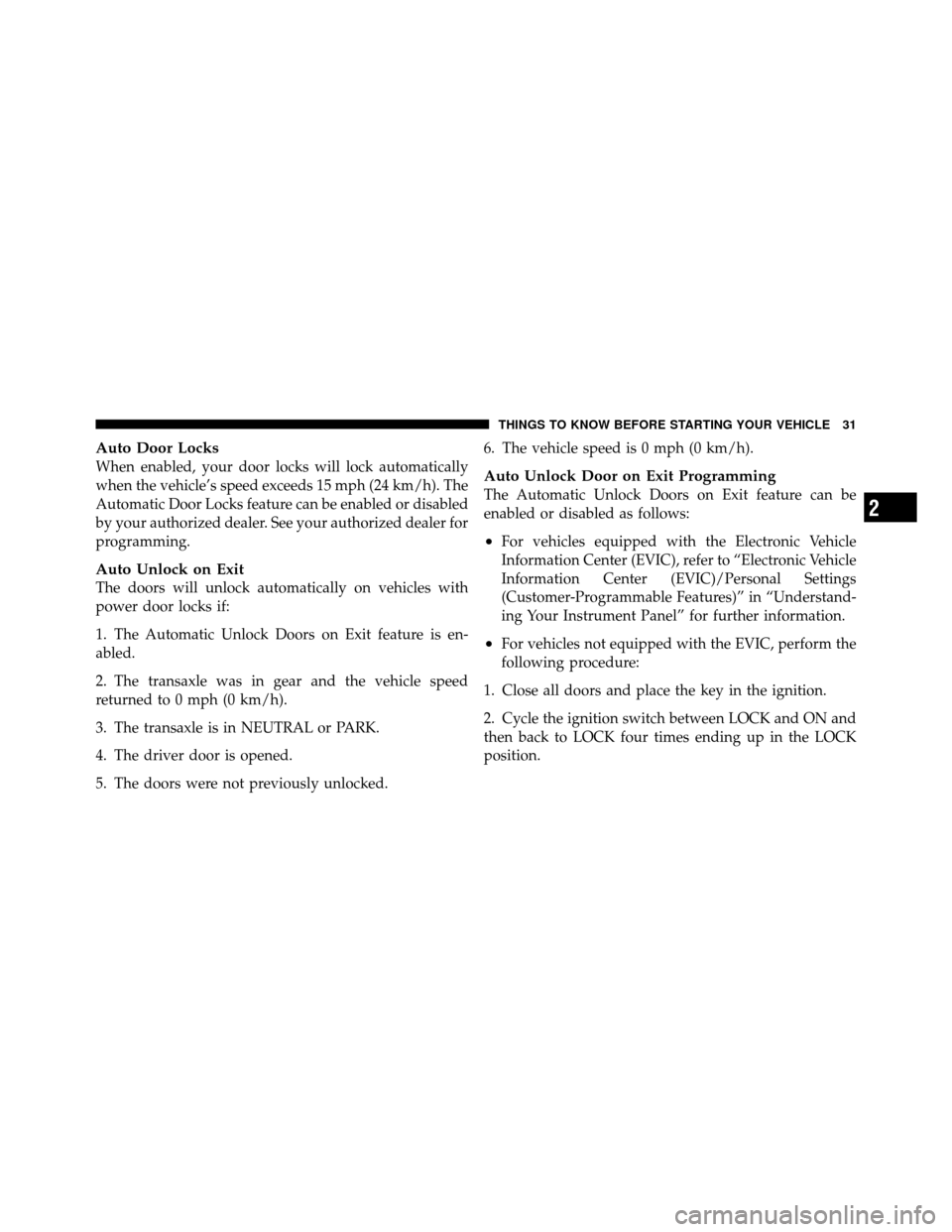
Auto Door Locks
When enabled, your door locks will lock automatically
when the vehicle’s speed exceeds 15 mph (24 km/h). The
Automatic Door Locks feature can be enabled or disabled
by your authorized dealer. See your authorized dealer for
programming.
Auto Unlock on Exit
The doors will unlock automatically on vehicles with
power door locks if:
1. The Automatic Unlock Doors on Exit feature is en-
abled.
2. The transaxle was in gear and the vehicle speed
returned to 0 mph (0 km/h).
3. The transaxle is in NEUTRAL or PARK.
4. The driver door is opened.
5. The doors were not previously unlocked.6. The vehicle speed is 0 mph (0 km/h).
Auto Unlock Door on Exit Programming
The Automatic Unlock Doors on Exit feature can be
enabled or disabled as follows:
•For vehicles equipped with the Electronic Vehicle
Information Center (EVIC), refer to “Electronic Vehicle
Information Center (EVIC)/Personal Settings
(Customer-Programmable Features)” in “Understand-
ing Your Instrument Panel” for further information.
•For vehicles not equipped with the EVIC, perform the
following procedure:
1. Close all doors and place the key in the ignition.
2. Cycle the ignition switch between LOCK and ON and
then back to LOCK four times ending up in the LOCK
position.
2
THINGS TO KNOW BEFORE STARTING YOUR VEHICLE 31
Page 33 of 457

3. Press the power door UNLOCK switch to unlock the
doors.
4. A single chime will indicate the completion of the
programming.
NOTE:This feature will not be functional until the
vehicle has been driven and the shift lever returned to the
PARK position.
5. Repeat these steps if you want to return this feature to
its previous setting.
NOTE: Use the Automatic Unlock Doors on Exit feature
in accordance with local laws.
WINDOWS
Power Windows
The window controls on the driver’s door trim panel
operate the door windows and the rear quarter windows. There is a single window control on the passenger’s door
trim panel, which operates the passenger door window.
The window controls will operate when the ignition
switch is turned to the ON or ACC position, and when
the accessory delay feature is active.
AUTO Power Window Switches
32 THINGS TO KNOW BEFORE STARTING YOUR VEHICLE
Page 34 of 457

NOTE:
•If a fluttering noise is heard from the rear seat belts
while driving with the windows down, safely bring
the vehicle to a stop and buckle the rear seat belts over
the empty seats. This will keep tension on the seat
belts and remove the fluttering condition.
WARNING!
Never leave children in a vehicle, with the keys in
the ignition switch. Occupants, particularly unat-
tended children, can become entrapped by the win-
dows while operating the power window switches.
Such entrapment may result in serious injury or
death.
Smart Glass Feature
The door window will lower slightly if the window is
fully up when opening the door. The window will return
to its full up position after closing the door. This action
allows the door to open without resistance and prevents
window and top seal damage.
Auto Window Down — If Equipped
The front window controls on the driver and passenger
door trim panels have an Auto-Down feature. These
switches are labeled AUTO to indicate this capability.
Push the window switch past the first detent, release, and
the window will go down automatically.
To open the window part way, push the window switch
to the first detent and release it when you want the
window to stop.
To cancel the Auto-Down movement, operate the switch
either in the up or down direction and release the switch.
2
THINGS TO KNOW BEFORE STARTING YOUR VEHICLE 33
Page 35 of 457
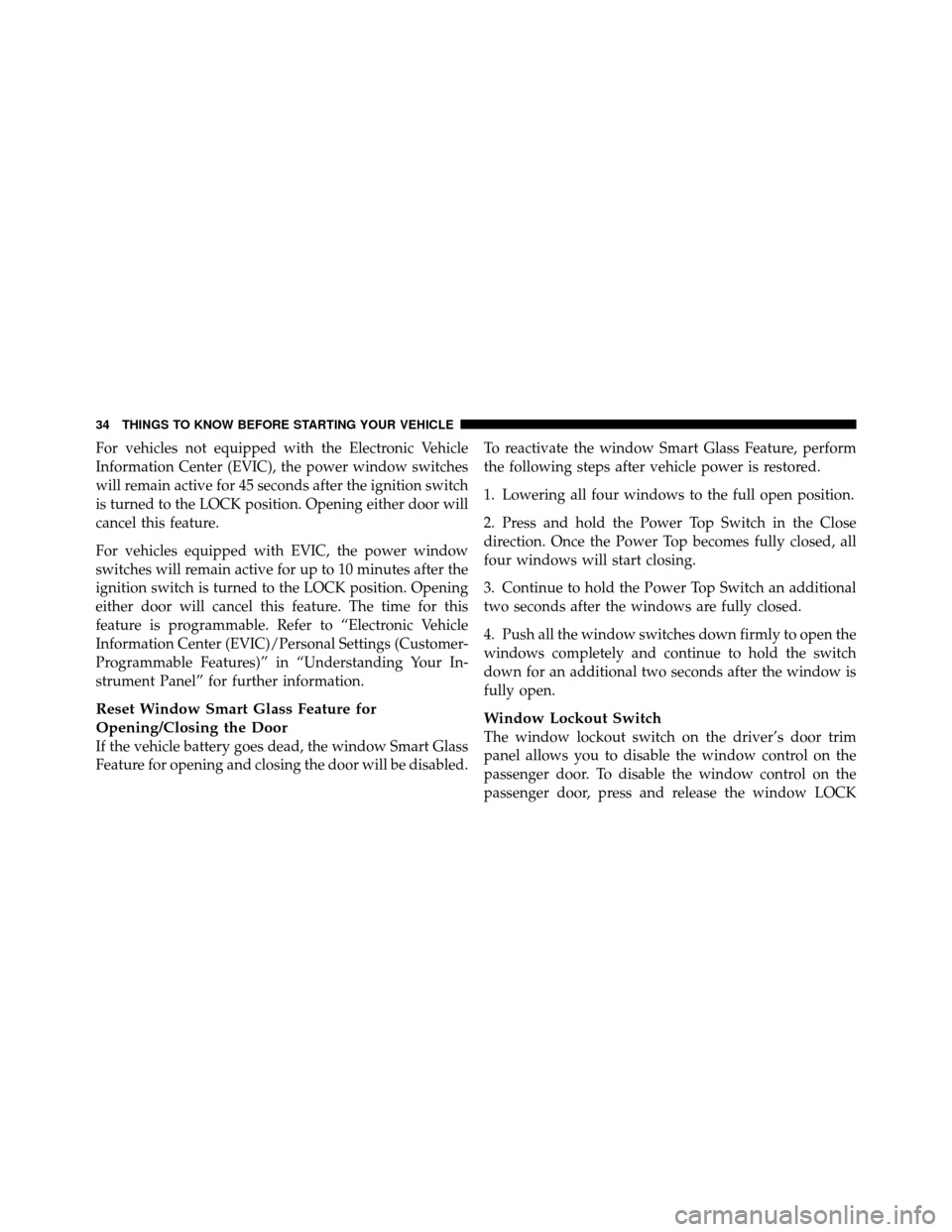
For vehicles not equipped with the Electronic Vehicle
Information Center (EVIC), the power window switches
will remain active for 45 seconds after the ignition switch
is turned to the LOCK position. Opening either door will
cancel this feature.
For vehicles equipped with EVIC, the power window
switches will remain active for up to 10 minutes after the
ignition switch is turned to the LOCK position. Opening
either door will cancel this feature. The time for this
feature is programmable. Refer to “Electronic Vehicle
Information Center (EVIC)/Personal Settings (Customer-
Programmable Features)” in “Understanding Your In-
strument Panel” for further information.
Reset Window Smart Glass Feature for
Opening/Closing the Door
If the vehicle battery goes dead, the window Smart Glass
Feature for opening and closing the door will be disabled.To reactivate the window Smart Glass Feature, perform
the following steps after vehicle power is restored.
1. Lowering all four windows to the full open position.
2. Press and hold the Power Top Switch in the Close
direction. Once the Power Top becomes fully closed, all
four windows will start closing.
3. Continue to hold the Power Top Switch an additional
two seconds after the windows are fully closed.
4. Push all the window switches down firmly to open the
windows completely and continue to hold the switch
down for an additional two seconds after the window is
fully open.
Window Lockout Switch
The window lockout switch on the driver’s door trim
panel allows you to disable the window control on the
passenger door. To disable the window control on the
passenger door, press and release the window LOCK
34 THINGS TO KNOW BEFORE STARTING YOUR VEHICLE
Page 36 of 457
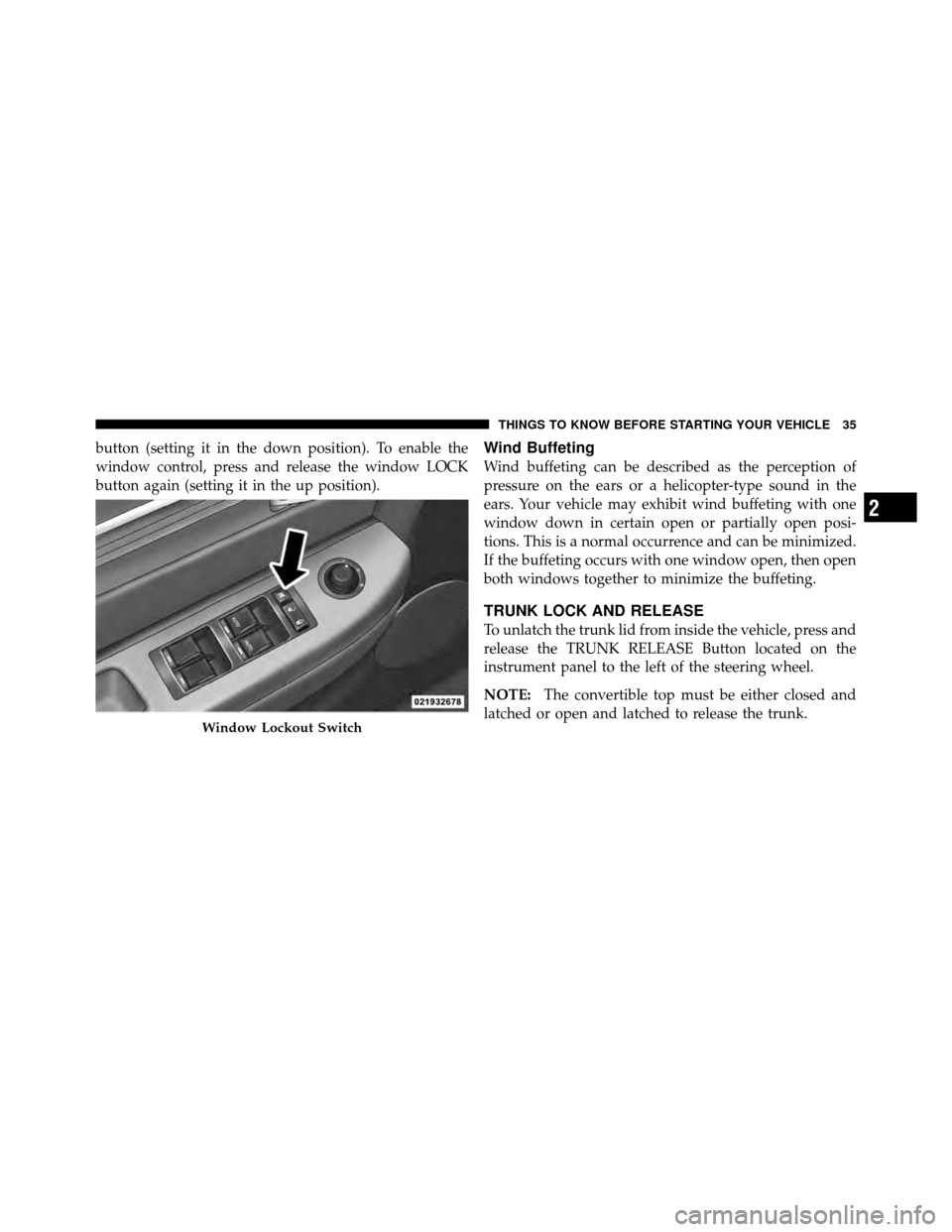
button (setting it in the down position). To enable the
window control, press and release the window LOCK
button again (setting it in the up position).Wind Buffeting
Wind buffeting can be described as the perception of
pressure on the ears or a helicopter-type sound in the
ears. Your vehicle may exhibit wind buffeting with one
window down in certain open or partially open posi-
tions. This is a normal occurrence and can be minimized.
If the buffeting occurs with one window open, then open
both windows together to minimize the buffeting.
TRUNK LOCK AND RELEASE
To unlatch the trunk lid from inside the vehicle, press and
release the TRUNK RELEASE Button located on the
instrument panel to the left of the steering wheel.
NOTE:The convertible top must be either closed and
latched or open and latched to release the trunk.
Window Lockout Switch
2
THINGS TO KNOW BEFORE STARTING YOUR VEHICLE 35
Page 37 of 457
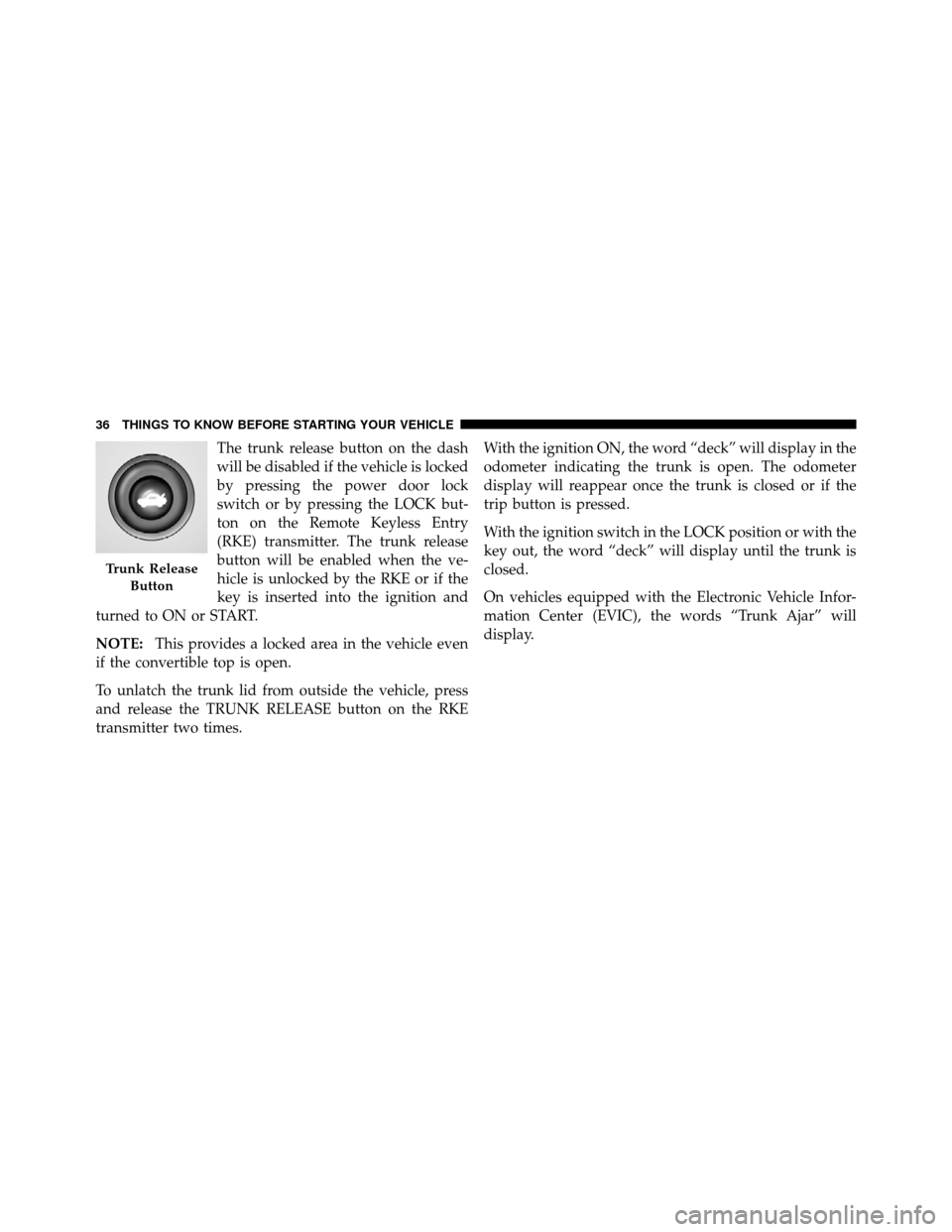
The trunk release button on the dash
will be disabled if the vehicle is locked
by pressing the power door lock
switch or by pressing the LOCK but-
ton on the Remote Keyless Entry
(RKE) transmitter. The trunk release
button will be enabled when the ve-
hicle is unlocked by the RKE or if the
key is inserted into the ignition and
turned to ON or START.
NOTE: This provides a locked area in the vehicle even
if the convertible top is open.
To unlatch the trunk lid from outside the vehicle, press
and release the TRUNK RELEASE button on the RKE
transmitter two times. With the ignition ON, the word “deck” will display in the
odometer indicating the trunk is open. The odometer
display will reappear once the trunk is closed or if the
trip button is pressed.
With the ignition switch in the LOCK position or with the
key out, the word “deck” will display until the trunk is
closed.
On vehicles equipped with the Electronic Vehicle Infor-
mation Center (EVIC), the words “Trunk Ajar” will
display.
Trunk Release
Button
36 THINGS TO KNOW BEFORE STARTING YOUR VEHICLE
Page 38 of 457
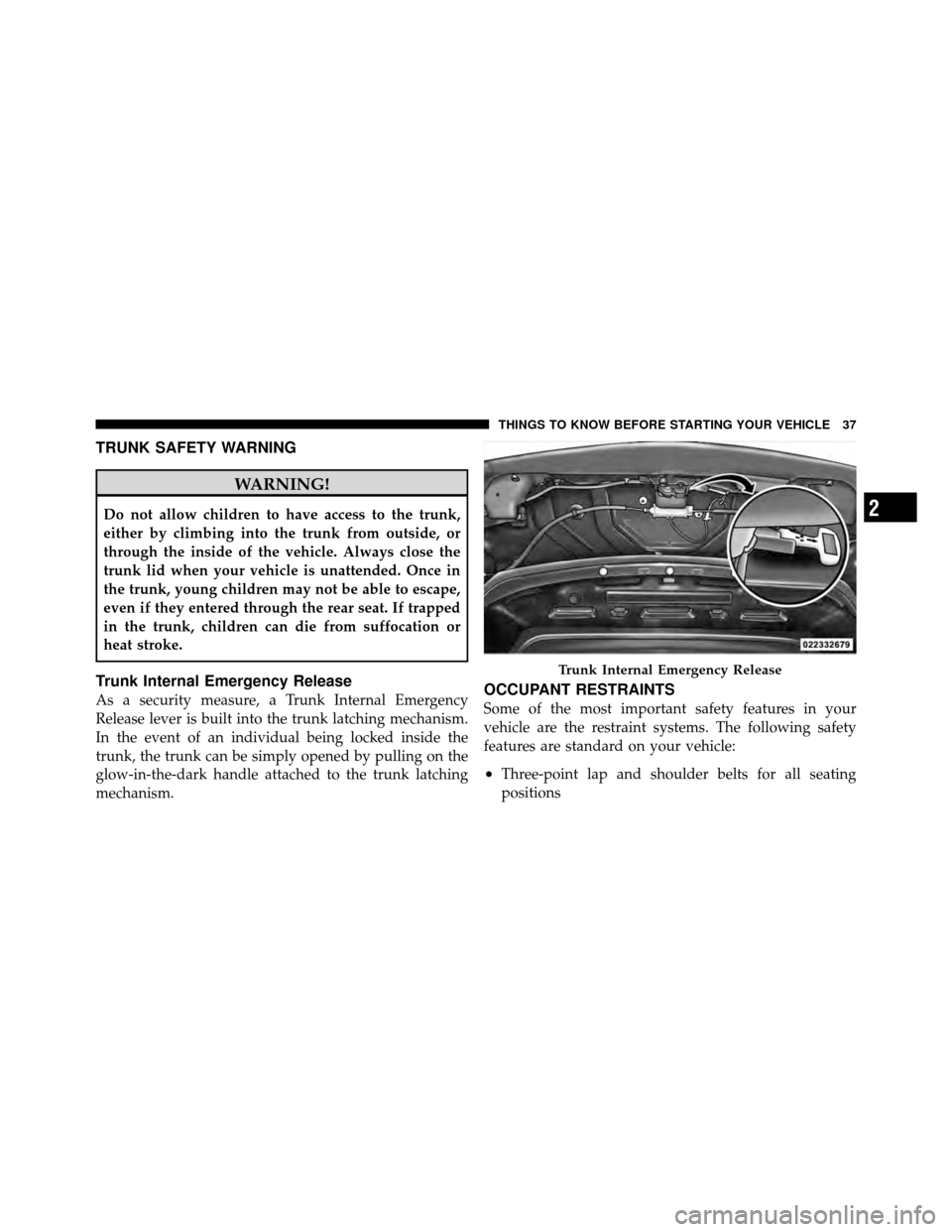
TRUNK SAFETY WARNING
WARNING!
Do not allow children to have access to the trunk,
either by climbing into the trunk from outside, or
through the inside of the vehicle. Always close the
trunk lid when your vehicle is unattended. Once in
the trunk, young children may not be able to escape,
even if they entered through the rear seat. If trapped
in the trunk, children can die from suffocation or
heat stroke.
Trunk Internal Emergency Release
As a security measure, a Trunk Internal Emergency
Release lever is built into the trunk latching mechanism.
In the event of an individual being locked inside the
trunk, the trunk can be simply opened by pulling on the
glow-in-the-dark handle attached to the trunk latching
mechanism.OCCUPANT RESTRAINTS
Some of the most important safety features in your
vehicle are the restraint systems. The following safety
features are standard on your vehicle:
•Three-point lap and shoulder belts for all seating
positions
Trunk Internal Emergency Release
2
THINGS TO KNOW BEFORE STARTING YOUR VEHICLE 37
Page 39 of 457
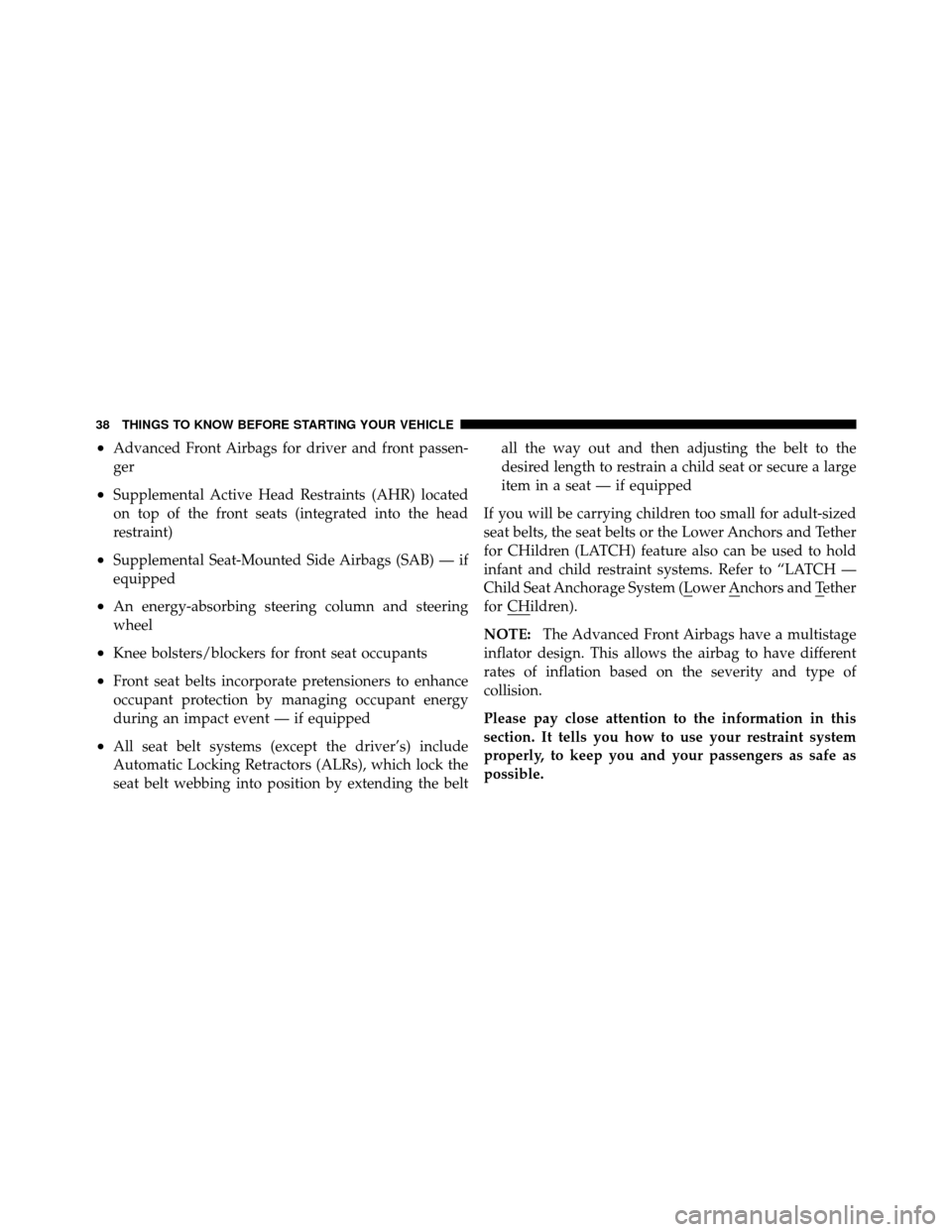
•Advanced Front Airbags for driver and front passen-
ger
•Supplemental Active Head Restraints (AHR) located
on top of the front seats (integrated into the head
restraint)
•Supplemental Seat-Mounted Side Airbags (SAB) — if
equipped
•An energy-absorbing steering column and steering
wheel
•Knee bolsters/blockers for front seat occupants
•Front seat belts incorporate pretensioners to enhance
occupant protection by managing occupant energy
during an impact event — if equipped
•All seat belt systems (except the driver’s) include
Automatic Locking Retractors (ALRs), which lock the
seat belt webbing into position by extending the beltall the way out and then adjusting the belt to the
desired length to restrain a child seat or secure a large
item in a seat — if equipped
If you will be carrying children too small for adult-sized
seat belts, the seat belts or the Lower Anchors and Tether
for CHildren (LATCH) feature also can be used to hold
infant and child restraint systems. Refer to “LATCH —
Child Seat Anchorage System (Lower Anchors and Tether
for CHildren).
NOTE: The Advanced Front Airbags have a multistage
inflator design. This allows the airbag to have different
rates of inflation based on the severity and type of
collision.
Please pay close attention to the information in this
section. It tells you how to use your restraint system
properly, to keep you and your passengers as safe as
possible.
38 THINGS TO KNOW BEFORE STARTING YOUR VEHICLE
Page 40 of 457
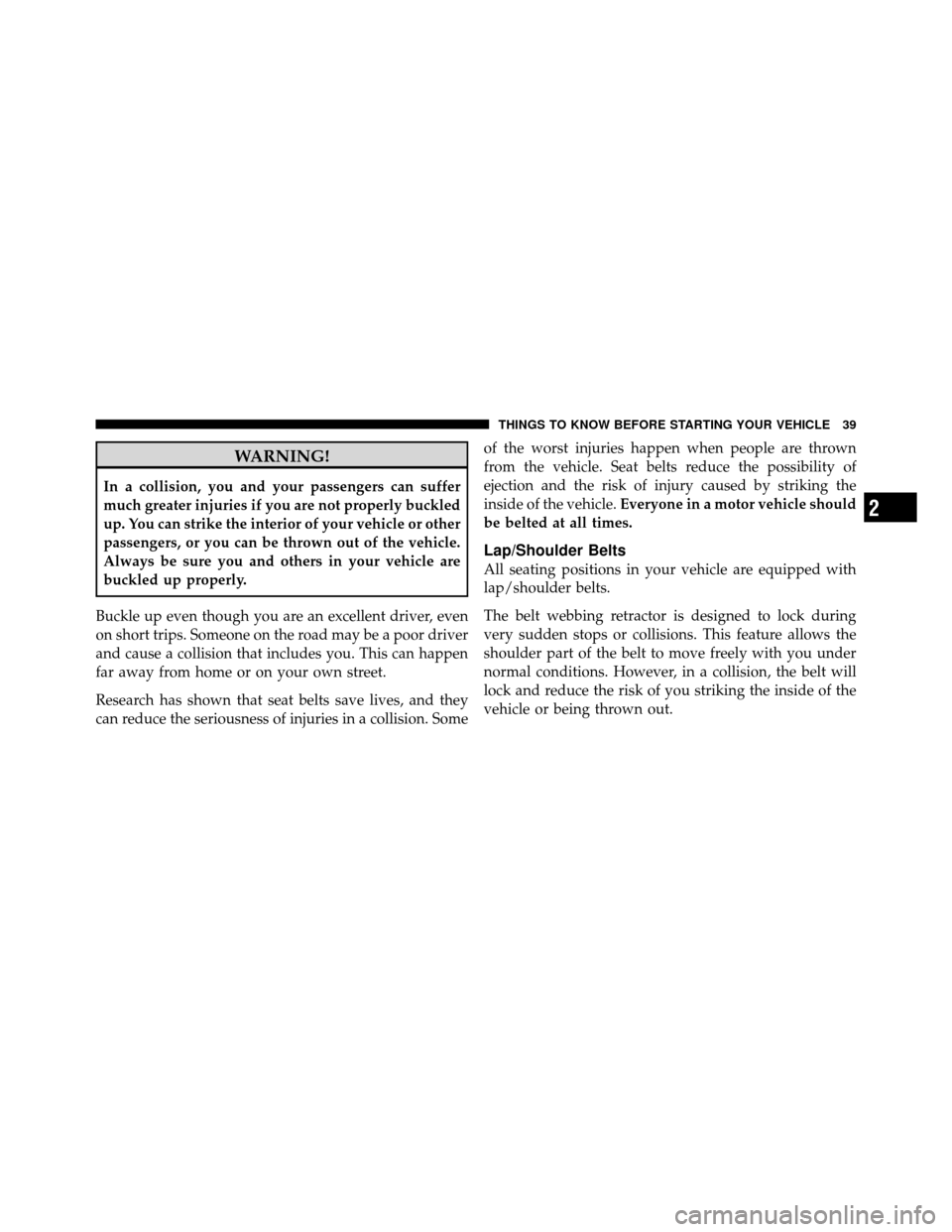
WARNING!
In a collision, you and your passengers can suffer
much greater injuries if you are not properly buckled
up. You can strike the interior of your vehicle or other
passengers, or you can be thrown out of the vehicle.
Always be sure you and others in your vehicle are
buckled up properly.
Buckle up even though you are an excellent driver, even
on short trips. Someone on the road may be a poor driver
and cause a collision that includes you. This can happen
far away from home or on your own street.
Research has shown that seat belts save lives, and they
can reduce the seriousness of injuries in a collision. Some of the worst injuries happen when people are thrown
from the vehicle. Seat belts reduce the possibility of
ejection and the risk of injury caused by striking the
inside of the vehicle.
Everyone in a motor vehicle should
be belted at all times.
Lap/Shoulder Belts
All seating positions in your vehicle are equipped with
lap/shoulder belts.
The belt webbing retractor is designed to lock during
very sudden stops or collisions. This feature allows the
shoulder part of the belt to move freely with you under
normal conditions. However, in a collision, the belt will
lock and reduce the risk of you striking the inside of the
vehicle or being thrown out.
2
THINGS TO KNOW BEFORE STARTING YOUR VEHICLE 39